![]()
![]()
![]()
Use LEFT and RIGHT arrow keys to navigate between flashcards;
Use UP and DOWN arrow keys to flip the card;
H to show hint;
A reads text to speech;
31 Cards in this Set
- Front
- Back
|
Cuticle |
Made of wax, purpose is to hold in water. Found everywhere but the bark and last inch of roots. |
|
|
Stomata (single:stoma) |
Holes in the underside of the leaves for breathing. K goes near the stoma, the stoma opens up. |
|
|
Leaves, roots, stems, flowers/fruit |
Leaves: photosynthesis Roots: for anchoring, absorbing minerals and water, stores starch Stems: connects leaves to roots. Flowers/fruits: reproductive system |
|
|
Vascular tissue Xylem and phloem |
Xylem: transports water and minerals up the roots Phloem: transports sugars from leaves to wherever is needed A) seeds (highest priority) B)flowers C) roots: to store food for the winter (lowest priority) |
|
|
Phylum bryophyta |
*Nonvascular No cuticles, no xylem or phloem, no stomata, leaves, roots, stems Yes cell walls, photosynthesis, and embryos Largest sex organs in plant kingdom, dominant gametophytes “Sex in the rain” |
|
|
Liver worts |
Wort: plant *Attributes 1)Thallus Gametophyte structures that grow flat and are flat 2) produce archegoniosphores that produce archegonioheads, that produce archegonia 3) produce Antheridiosphores that produce Antheridial heads, that contain antheridia inside antheridial chambers 4) reproduce asexually using gemmae or a Gemma 5)anchor their thallus using rhizoids 6)sphorophytes use a foot to suck nourishment from the photosynthesizing gametophyte |
|
|
Antheridium |
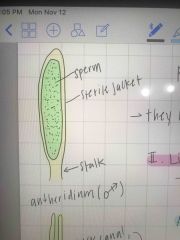
|
|
|
Archegonium |
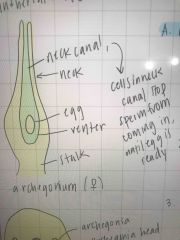
|
|
|
Archegonia head |
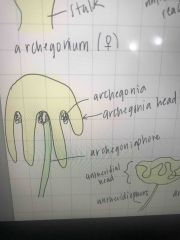
Back (Definition) |
|
|
Antheridial head |
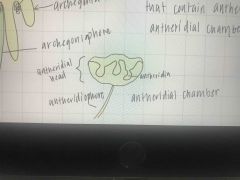
Back (Definition) |
|
|
Sphorangium |
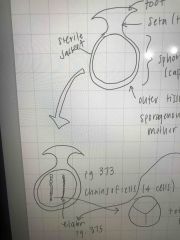
Back (Definition) |
|
|
Calyptra |
An enlarged archegonium |
|
|
Elater |
Some spore mother cells don’t go through meiosis elongates and develops a twisty cell wall Part of the hygroscopic spore dispersal structures When elaters dry out they snap and crackle to shake out the spores, only in dry weather Only for liverworts and horse tails |
|
|
Mosses |
Same phylum as liverworts No cuticle, no way to hold in their water Love living in the mouths of caves Mosses have phyllodes instead of leaves and rhizoids instead of roots |
|
|
Poikilohydric |
Amount of water they have match the water in the climate |
|
|
Protonema |
Thread like structures on the early stages of mosses and liverworts |
|
|
Peristome teeth |
Part of the hygroscopic dispersal structures, only for mosses |
|
|
Spore dispersion in mosses |
The calyptra falls off The operculum has to fall off “Operculum” means to cover something The peristome teeth have to dry out to open and so the spores then fall out. Spores release when humidity is also low |
|
|
Monilophyta (ferns) |
Second most abundant plant Ferns and horse tails have glass cell walls *characteristics A.) vascular tissue Xylem must be dead and hollowed to work, act like straws to move water up Phloem moves sap B.) cuticle All plants have embryos C.) dominant sporophytes Don’t make seeds, makes spores |
|
|
Life cycle of monilophyta (ferns) |
Spores blow when it’s windy and dry. Sprout and make gametophytes. A.) spores germinate into prothalli Sex organs look the same as those of phylum bryophyta but smaller and less B.) the prothalli are hemaphroditic (produce antheridia and archegonia) on the same prothallis Antheridia are produced and release sperm. Then a few weeks later archegonia are produced. C.) leaves are called fronds Zygotes are the first cell of the sporophyte Fiddlehead: young leaf Some fronds have sori D.) fronds often produce sori on their underside When it dries out, it straightens and deprecated lip cells to release spores |
|
|
Sori |
Sori are clusters of sporangia Fronds often produce sori If a fern doesn’t cover their sori with something they would be called a naked sori |
|
|
Indusia (in ferns) |
Specialized structures shaped like tiny mushrooms that cover each sori False indusia are leaf edges |
|
|
Globular lobes |
Specialized spheres that produce sori inside When species do this, they make them in fall and release in spring |
|
|
Horse tails (equisetum) |
Equi: horse Setum: tail Sporophytes has silicon dioxide (glass) to reinforce the cellulose of its cell walls. Hollow on the inside but sturdy. Each spore has four elaters stuck to it |
|
|
Nodes (in equisetum) |
They have microphylls whorled around the stem at various intervals called nodes, nodes are where leaves come out Internodes are parts between the nodes |
|
|
Strobili (in equisetum) |
Strobilus: plural Form at the tops of stems. They’re sporophylls compacted together to produce sporophytes Their leaves are not called leaves, but microphylls |
|
|
Hygroscopic |
Changes shapes depending on water |
|
|
Phylum lycopodiophyta |
All species have microphylls |
|
|
Lycopodium |
Most produce Strobili Most spores produced by lycopodium are explosive |
|
|
Selaginella |
Sometimes makes Strobili Most species don’t produce it. Some species are poikilohydric; when they are dry, they become brittle and can break |
|
|
Differences between lycopodium and selaginella |
*Selaginella Always has a ligule at the base of every leaf. Including sporophylls Selaginella spores look different. (Heterosporous) *lycopodium All spores are the same Doesn’t have ligules Homosporous |

